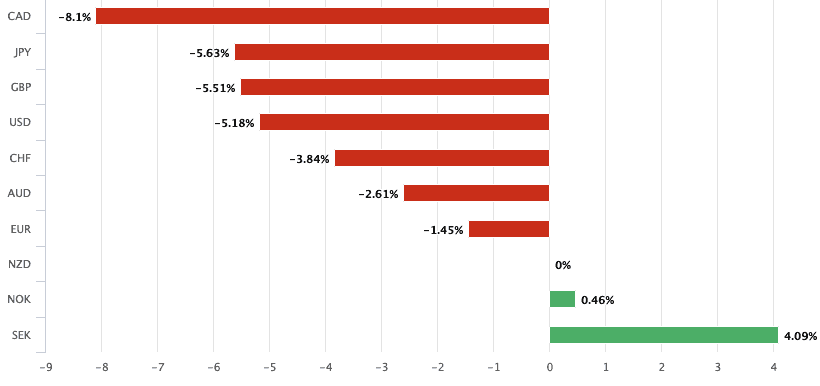ASB see Additional Downside in New Zealand Dollar on back of Critical RBNZ Meeting

Image © Adobe Stock
- New Zealand Dollar weakness can extend this week
- RBNZ tipped to cut interest rates
- Deterioration in labour market stats key to RBNZ thinking
Analysts at New Zealand lender ASB say they see further New Zealand Dollar weakness in the coming week as they expect the Reserve Bank of New Zealand (RBNZ) to cut interest rates again on Wednesday.
Wednesday sees the RBNZ meet to decide on where the country's base interest rate should be, while they will also guide markets on what to expect with regards to future interest rate levels.
"We’re entering another important week," says Nick Tuffley, Chief Economist at ASB in Aukland. "The hump day RBNZ meeting promises to be one of the more eventful in recent times given financial markets and economists are split on what the Bank will do."
Currently, market participants are erring in favour of an interest rate cut to be delivered, with interest rate markets pricing in a 65% probability of a cut in the basic rate from 1.0% to 0.75%.
"Global growth is still sub-par, business confidence is woeful, and a few cracks are appearing in the labour market," says Tuffley.
A cut to the New Zealand interest rate would in theory promote economic growth as the cost of borrowing across the economy falls, leading to increased investment.
However, a side effect of lowering interest rates is a decline in attractiveness of New Zealand as a destination for foreign investor capital: cutting the basic interest rate also cuts the return on investment across a whole array of New Zealand investment products.
Hence, the rule-of-thumb in foreign exchange markets is that a currency tends to fall when its issuing central bank lowers interest rates.
If we look at the below chart, we can see the NZ Dollar has been one of the worst performing major global currencies, thanks in part to the RBNZ's decision to lower interest rates:

Above: NZD's performance against other major currencies in 2019
Key for the currency mid-week will be whether the RBNZ signals it is willing to go yet further and deliver more interest rates in the future. If so, then we might expect a trend of NZ Dollar weakness to extend.
"We expect the RBNZ to cut the OCR 25bps next week at the November MPS and signal that further cuts remain a possibility should the dataflow and outlook warrant – we expect it will, in time," says Sharon Zollner, chief economist at ANZ. "We continue to expect further rate cuts in February and May next year, aimed at preventing inflation and inflation expectations from slipping further. This would take the OCR to a new record low of 0.25%," says ."
The last week has seen the NZ Dollar extend losses, "as interest rate market pricing for a RBNZ rate cut edged slightly higher over the week. Economists and market participants appear divided on the likelihood of the RBNZ cutting the OCR 25 basis points this week, but the lift in the unemployment rate (from 3.9% to 4.2%) did sway market expectations slightly in favour of a cut," says Tuffley.
https://www.poundsterlinglive.com/nzd/12354-new-zealand-dollar-ducks-for-cover-ahead-of-jobs-data-as-market-eyes-rbnz
The RBNZ said in August and September, after the jobless rate had fallen to its earlier 3.9% level, that Kiwi employment had reached its "maximum sustainable level" before committing in both months to using interest rate policy in order to keep maintain that status quo.
That commitment by the RBNZ is in line with the new mandate to target employment, which it has been operating under since April 01.
The new mandate, a product of the Labour Party and New Zealand First coalition government, saw the bank become obligated to use interest policy to "support maximum sustainable employment" in addition to keeping inflation "near the 2 percent mid-point" of the target range. ANZ, one of New Zealand's largest banks, says this and other factors mean the RBNZ will cut the cash rate next week and on two more occasions before long.
"The New Zealand economy is experiencing slipping growth, not a sudden tilt into recession. Nonetheless GDP growth has halved, from 4.1% in 2016 to 2.1% at the last read (Q2). It is difficult to know what to make of such a slow slide," Zollner writes, in a note to ANZ clients Tuesday. "If you don’t have much ammo, come out firing’ has been the approach thus far, and we are assuming they’ll stick to the general principle of it being better to risk overdoing it than miss the boat. It’s a long time until the next rate-cut opportunity in February."




